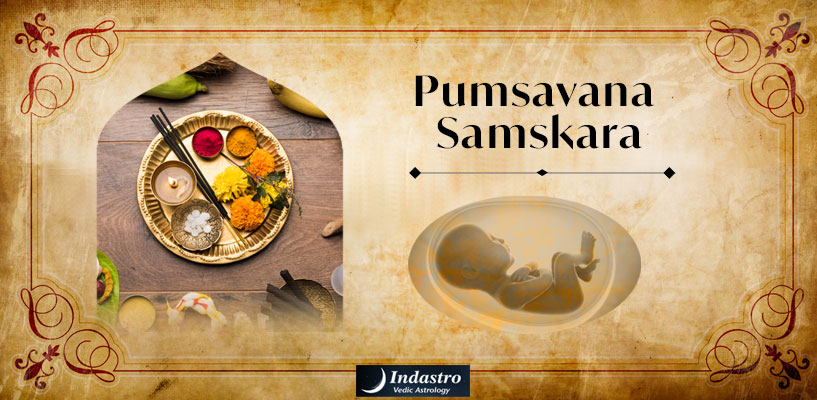Ritual to Prevent Miscarriages (Pumsavana Samskara)
This ritual is connected to prenatal pregnancy. It enhances the energy of the foetus to make it healthy and strong to sustain the process of pregnancy.
Pumsavana is the second samskara for the baby in the womb and is performed after the conception ceremony, Garbhadhana. It is also known as Anavalobhan Samskara. ‘Avalobhan’ means miscarriage. Hence, Anavalobhan is performed to prevent miscarriage of the foetus. This ritual also helps in imparting knowledge to the foetus in the womb.
When is Pumsavana Samskara performed?
- This samskara is performed after the conception ceremony (Garbhadhana Samskara ).
- It is done on the day of Pushya Nakshatra since it is directly connected to the health of a baby. In fact, it is performed on the first Pushya Nakshatra after the mother confirms that she has conceived.
- It is performed with the understanding that humans are made up of both masculine and feminine energy and that the aim of this samskara is to make the child healthy, strong and brilliant irrespective of its sex.
- It should be performed before the end of the second month after the conception of the baby.
What is the purpose of Pumsavana Samskara?
There is a myth that those who want a son should perform this samskara. But this is not true. Hindu scriptures and Sanatana Dharma do not mention any kind of gender/sex differentiation when Pumsavana Samsakara is performed.
There are two elements in every human being - the feminine and masculine energy. This samskara only enhances the masculine energy of the foetus to make it healthy and strong to sustain the process of pregnancy. It is not to ensure the birth of a male child.
How is Pumsavana Samskara performed?
- The parents, after their bath, pray to Lord Ganesha for good health, wellbeing and future of the child.
- One can also perform a Yagna, chant Gayatri Mantra, and offer Kheer as prasad.
- The parents must eat the prasad and seek blessings of the elders.
- The parents can also feed the poor and make donations.
- Nasya Karma is also conducted during this ritual.
What is the purpose of Nasya Karma Sankalpa in this ritual?
Nasya Karma is the process where herbal medicines are mixed with milk and a few drops of this mixture are put in the nostrils of the mother. Since the nose is connected to the brain, this concoction is believed to boost favorable hormones in the mother to make the baby strong and healthy.
Procedure for Nasya Karma Sankalpa:
- The father has to invoke the Lord with the verse, ‘I am performing this samskara of Anavalobhan for the well-being of the foetus and to overcome the defects of the womb and ovum in the womb of my wife. Also please enlighten the foetus with knowledge.’
- Put a few drops of Druva juice into the right nostril of the pregnant woman with the help of the right thumb while reciting the mantra below:
ॠजापतये सà¥à¤µà¤¾à¤¹à¤¾ । जापतय इदं न मम ।
The pregnant woman should recite this mantra and touch the husband’s hand; the husband should repeat the above-mentioned mantra and offer cooked rice to deity Prajapati. Then the husband should touch his wife’s heart with his palm.
Science behind Pumsavana Samskara
This ritual is about administering herbal medicine through the nose to the pregnant woman. In the current times when the air is extremely polluted, this ritual becomes even more crucial because pollution can affect a person with several respiratory diseases like congestion, allergies, chronic cough, rhinitis, and other breathing problems. In chronic stage, this might develop into COPD, asthma and bronchitis, etc. Administering herbs into the nostrils prevents the inhalation of unwanted particles in the air and increases the immunity of the mother and child.
There are six arterial branches that serve the nasal cavity, making this region a very useful route for drug delivery and a pathway to the brain. This ritual creates an opportunity for the parents and family to cherish and shape up the first impression of the baby. It also creates a positive ambience that encourages positive thinking and positive attitude in the mother that can go a long way in ensuring the mental and physical well-being of the baby in her womb.
Indastro top 10 Products
Translate











 Maharashtra Day- Analysis of COVID wave, when will it subside
Maharashtra Day- Analysis of COVID wave, when will it subside
 Yoga for Government Jobs
Yoga for Government Jobs
 National Doctor's Day - What kind of Specialty doctor will you become, based on your zodiac?
National Doctor's Day - What kind of Specialty doctor will you become, based on your zodiac?
 Astrological facts about brother-sister relationship
Astrological facts about brother-sister relationship
 Which Power Color to Flaunt if you are a Leo Native!
Which Power Color to Flaunt if you are a Leo Native!
